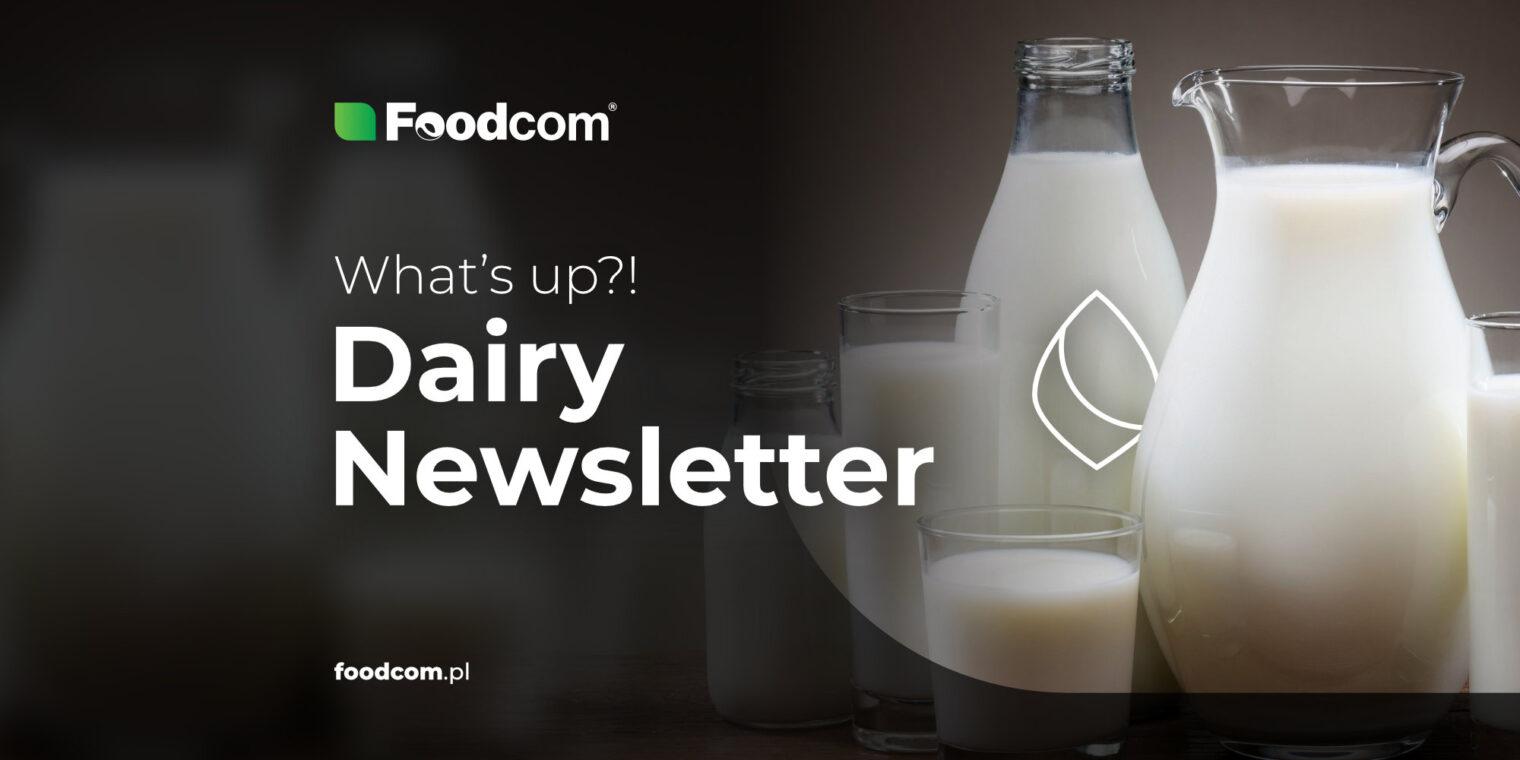The situation in the dairy sector is that everyone who can is trying to liquidate their stocks from the warehouse. Recently, there have been quite a few contracts for Butter (which is quite interesting, since it is not liquid, and yet it is apparently being liquidated as well). The hot topic last week was Cheeses, including Cagliata, which was very popular. Whey Protein Concentrate saw the biggest increase of dairy commodities, and there are many indications that the upward trend will continue in the coming weeks. As always, to learn more about the situation of each product, read on.
As for a more general description of the current market situation, it must be said that many have clearly entered the vacation season, during which they do not make many purchases. At the same time, demand from the countries where tourists are currently traveling to continues to increase. Perhaps this is a good time to grab the best deals, when some players are not active in the market… It’s certainly worth considering.
What many are currently concerned about is the long-term market forecast. Some accept the fact that the vacation season has already begun and not much will happen in the coming weeks, while others say it’s still two weeks away. Both groups are asking: what will the market look like when we return from the vacation? The answer to this question is not clear at this point, but it will certainly appear in the next issues of the newsletter. So check your email inbox regularly!
Continue reading to learn about this week’s market insights.
With us, you’ll never miss a thing!
Butter
Last week showed a different sentiment regarding the sales of Butter without much action happening on the market. The manufacturers came to the conclusion that the only way to monetize the product is to accept the lower prices coming from the consumers. A lot of planning has been made recently to close all running affairs and attend the scheduled vacation, announced earlier by the sellers.
Skimmed Milk Powder
Last week also showed a sign of easing from the EU sector mainly caused by Arla selling the product on the GDT platform and the prices closing around the area of 2.30 EUR/KG FAS. It’s hard to predict the continuity of the export demand and how will it change further. China, which consumed the Q2 production, is not willing to sell all the remaining volumes allocated in the European Union, yet.
Gouda/Edam
The prices of the Cheese commodity remain strong compared to the other products mentioned in our newsletter. Manufacturers are not feeling a lot of pressure to come down from the quoted prices, which allows them to keep the products’ value. Even though Dutch-type Cheeses are in the spotlight, we observe a building interest in Swiss-type Cheeses like Emmental, for which we see continuous demand.
Full Cream Milk Powder
Last week we observed the Mediterranean region actively purchasing. This trend has also continued this week. We have the impression that the last remaining inquiries and demand are for the pre-vacation purchases that stabilize the offers in terms of price. The inquiries also set visible signs of demand in the current market. A difference started showing up when we compare the CEE sector and Western Europe. It seems the further west and south you go, the cheaper the product.
Cream
Last week the prices for Cream slightly dropped (about 100-150 EUR/MT down) because of a weaker demand around Europe. Nevertheless, prices for raw milk were stable. The situation was similar for SMC. We will see what the summer will look like…
Europe
Supply exceeds demand in the EU.
Despite a year-on-year decline in raw milk production in selected European Union countries, overall demand in the EU is lower than current supply. As is the case every year at this time, intense purchasing activity is taking place in the south of the continent, including Italy and Greece, where the busy vacation season has already begun. At the same time, Northern Europe, which has surpluses, is now export-oriented, with the raw material being processed into butter, milk powder and whey.
Is a crisis looming in the British dairy industry?
Representatives of the British dairy industry warn that if the labor shortage problem is not solved soon, not only could milk prices continue to rise, but there could even be a collapse in production. The UK dairy industry has been struggling for some time with the consequences of the pandemic and the war in Ukraine. After Brexit, the problem of labor shortages has become even more acute. According to farmers and processors, if the problem is not resolved quickly, it could soon turn into a serious crisis for the entire sector.
Danone appeared among 75 companies France has asked for price cuts.
By this move, the French government could force some of the companies that have had price increases of 10 percent or more in recent months to re-open negotiations on prices with major retailers, and pressure their profit margins. In response, investors have warned that consumer goods companies should start easing price increases as supply chain costs decline, worried that further hikes could hit market share and margin growth.
The Americas
Milk processors in the U.S. cannot keep up with farmers.
More and more material is surfacing on the Internet showing that American farmers, especially those in Minnesota, are pouring their milk down the drain. The reason is the oversupply of raw milk and the limited capacity of processors, who cannot take as much raw milk as farmers supply. Therefore, the latter are forced to dispose of the milk instead of selling it. Some farmers have started selling their cows to reduce oversupply. No reason to cry over spilled milk? Some have doubts…
Dairy exports in Chile fell, in comparison to the previous year.
After notable growth in 2022, Chilean dairy exports declined in the first five months of 2023. The newest data says that dairy exports in May totaled US$ 102.4 million, which represents a drop of 8.8% and shows a reduction of US$ 9.9 million compared to the same period in 2022. There is also a decrease in volume of the dairy exports at the end of May of 12.1% to 34,554 total tons, with 4,812 tons less compared to 2022.
Surplus is coming, spells the new USDA Milk production report.
Market intelligence representatives at Ever.Ag Insights, share that it is partially caused by slowed on-farm liquidations and slaughter rates. Although the situation might look unstable, the Global Dairy Trade event showed no change in the overall price index. Butter gained 5.5%, cheese dropped 3.3%, skim milk powder was down 2.3%, and whole milk powder was unchanged.
Asia & Oceania
Traditional Chinese medicine in the service of dairy cows.
Bupleurum, a herbal supplement that has been used for centuries in Chinese medicine to support liver function and to treat colds and flu, is now expected to help cows as well. A recent study found that adding bupleurum to cows’ feed helped reduce the negative effects of the heat stress to which they are exposed. If the effectiveness of the use of Bupleurum is indeed confirmed, it would be an important support for cow breeders because the negative effects of heat stress include damage to the immune system of cows, the development of metabolic diseases, changes in hematological parameters and complications in reproduction.
Milk prices are rising, dairy commodity prices are falling.
At the beginning of the new season, farm gate milk prices in Australia are higher than in the same period last year. At the same time, dairy commodity prices are down compared to last year. The combination of these two conditions makes the current times not easy for Australian dairy processors. On top of that, they have energy, labor and transportation costs to cover. Some say dairy processors in Australia pay up to 20% more for milk than their counterparts in New Zealand, which reduces the price competitiveness of their end products. As a result, even on the shelves of Australian supermarkets, New Zealand butter and cheese are cheaper than locally manufactured products.
High temperatures threaten cattle in China.
Current high temperatures in northern China have led to a drought that poses a threat to people, farmland and livestock. An estimated 760 000 large livestock do not have access to sufficient water. Among the regions hardest hit by the extreme weather conditions is the northwestern region of Inner Mongolia, known for its large pastures where sheep and cattle graze. This means that cows could soon be short of both water and feed. At this point, it is unclear what the long-term effects of the current situation will be.







